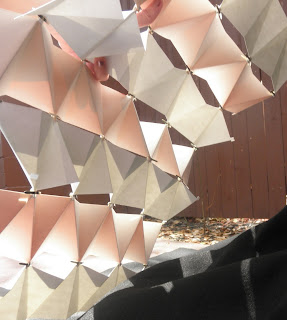




A place for meditation?

















 The triangulated wall panels work to create a flexible wall system that can adapt to the designer's needs. Variations in the triangle orientation create voids that angle towards either the interior or exterior. Exterior angled voids could direct fluids to drain to the interior, and interior angled voids permit sunlight to filter through. The voids can be increased or decreased in size simply by altering the size of the triangles. Flexible joints, such as these brass fasteners allow the wall system to mold to any desired shape.
The triangulated wall panels work to create a flexible wall system that can adapt to the designer's needs. Variations in the triangle orientation create voids that angle towards either the interior or exterior. Exterior angled voids could direct fluids to drain to the interior, and interior angled voids permit sunlight to filter through. The voids can be increased or decreased in size simply by altering the size of the triangles. Flexible joints, such as these brass fasteners allow the wall system to mold to any desired shape.



 The material to be laser cut is 4 ply grey strathmore; therefore, a test cut was done to find the appropriate notch width for the final piece
The material to be laser cut is 4 ply grey strathmore; therefore, a test cut was done to find the appropriate notch width for the final piece Because the pieces to be laser cut were taken from rhino all the offsetting, trimming and line work needed to be done in CAD. This part particularly tedious because of the quantity of pieces. Better option anyone? Grasshopper?
Because the pieces to be laser cut were taken from rhino all the offsetting, trimming and line work needed to be done in CAD. This part particularly tedious because of the quantity of pieces. Better option anyone? Grasshopper? Pieces were grouped and laid out according to the order they were to be assembled.
Pieces were grouped and laid out according to the order they were to be assembled.